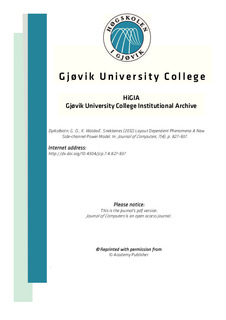Layout Dependent Phenomena A New Side-channel Power Model
Journal article, Peer reviewed
Permanent lenke
http://hdl.handle.net/11250/142552Utgivelsesdato
2012Metadata
Vis full innførselSamlinger
Originalversjon
Dyrkolbotn, G. O., K. Wold&E. Snekkenes (2012) Layout Dependent Phenomena A New Side-channel Power Model. In: Journal of Computers, 7(4), p. 827-837. http://dx.doi.org/10.4304/jcp.7.4.827-837Sammendrag
The energy dissipation associated with switching
in CMOS logic gates can be used to classify the microprocessor’s
activity. In VLSI design, layout dependent phenomena,
such as capacitive crosstalk, become a major contributor
to the power consumption and delays of on-chip busses
as transistor technology get smaller. These effects may be
known to the security community but have received little
attention.
In a recent paper we presented a new power model, taking
into consideration capacitive crosstalk. We have shown
that capacitive crosstalk has a significant effect on gate
energy dissipation. Our results confirm that the dissipated
energy from CMOS switching gates depends not only on
the hamming distance (HD), but also on the direction of
switching activity on nearby data lines. We show that for an
8 bit data bus, crosstalk may improve detection performance
from 2.5 bits (HD based detector) to a theoretical 5.7 bits and
simulated 5.0 bits (crosstalk based detector) of information
per sample.
In this paper we elaborate on the theory and simulations
of layout dependent phenomena and how they must be
considered when analyzing security implications of power
and electromagnetic side-channels. We have also added a
small case study, i.e. the electromagnetic side-channel of a
smart card, that supports our simulations/theoretical results.
Beskrivelse
This is the journal's version originally published in Journal of Computers: http://dx.doi.org/10.4304/jcp.7.4.827-837. This is an open access journal. Reprinted with permission from Academy Publisher.
